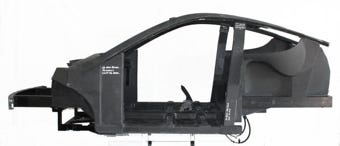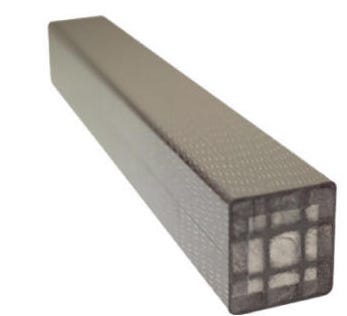Carbon fiber body-in-black wins design accolade
A plug-in hybrid electric vehicle weighing just 500 kg thanks to an all-carbon structure has come out tops in the automotive category of the JEC Innovation Awards Program recognizing excellence in composite design and application.Body-in-black car body pushes new limits to lightness.
March 8, 2012
A plug-in hybrid electric vehicle weighing just 500 kg thanks to an all-carbon structure has come out tops in the automotive category of the JEC Innovation Awards Program recognizing excellence in composite design and application.
|
Body-in-black car body pushes new limits to lightness. |
|
Closed cell foamed LDPE packs out structural space frame. |
Specialist vehicle manufacturer Axon Automotive (Northamptonshire, UK) led the project with partners Toray Industries (Tokyo, Japan, carbon fiber); Eurocarbon (Sittard, the Netherlands, braiding); Scott Bader (Northamptonshire UK, a new resin formulation) and Eccles Tooling Systems (West Midlands, UK, patterns).
The compact Axon car has also been designed for scalable production and is suitable for new fuel vehicles and prestige vehicles. The material innovation consists of using a braid over a foam preform, thus effectively creating a 3D woven structure from multiple preforms that are machine-laid and infusion-molded into beams. These beams have an internal structure that can resist buckling and deformation.
Low-density, closed-cell polyethylene foam forms the core of the preform, which is placed into a closed tool with multiple cells and formed by vacuum-assisted resin transfer molding (VARTM). The foam core expands during the process and takes the shape of the tool.
The special feature of Axon Automotive's Axontex structural space frame process is the shear webs internal to the beam, which give the beam its high strength and stiffness while retaining a low weight and allowing high levels of shape and curvature within the components. Load introduction for safety belts, engine mounts, seats and crash structures rounds out the BiB system.
Working with their suppliers, Axon has been able to apply a new resin system that increases toughness while retaining the conventional stiffness and strength of epoxy, at lower cost and greater customization ability. Instead of creating designs by substituting materials in existing architectures, new composite configurations and the development of supporting manufacturing processes allow the creation of breakthrough, cost-effective and higher-value components.
Key benefits of the new design approach include affordable bespoke design for new vehicle architectures; low tooling costs allowing cost-effective scalable production through adding tooling to match demand (up to 50% lower compared with conventional "body in white" vehicles); ultra-lightweight vehicles allowing electric powertrains, lower fuel consumption and lower CO2 emissions; rapid model replacement for shorter model cycles and improved competitiveness; and modular design allowing low-cost tooling changes across platforms. Modular design is emerging as a concept in the automotive sector, even for traditional vehicle formats.
Existing OEMs manufacturing prestige low-volume steel bodied vehicles can clad carbon BiB with painted steel panels, while new entrant OEMs can use new resin-based exterior materials. Both applications are based on a vehicle assembly concept where components are fitted onto the BiB and the exterior panels are fitted last maximizing ease of production and minimizing risk to the final panels.-[email protected]
About the Author(s)
You May Also Like




